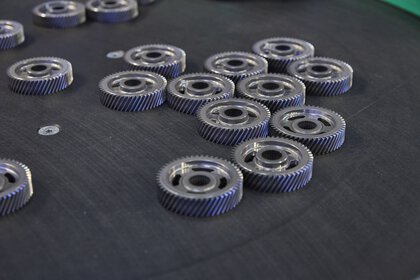Powder metallurgy: Experience innovations live at ceramitec
The powder metallurgy sector is constantly undergoing technological development, and at ceramitec the innovations this produces—which are more than capable of keeping pace with competitor technologies—can be experienced at first hand.
Efficient and sustainable production in a world that is changing faster than ever? Flexibility in manufacturing processes and materials in demand. Powder metallurgy is responding to this trend with numerous innovations. Well-known exhibitors from all over the world will be presenting their innovations at ceramitec. Find out more about the challenges of powder metallurgy processes.
What is powder metallurgy?
From ceramic powder to a solid component: Powder metallurgy manufacturing processes break down raw materials, shape them, and solidify them in elaborate sintering processes to create heat-resistant and lightweight components. Without them, many industries would not be what they are. The cost-effective and flexible manufacture of ceramic components and products with application-specific properties in highly complex shapes is in demand in many industries.
What are the individual steps in the process?
In three production steps, powder metallurgy produces lightweight, durable, and robust components that can be ground, polished, or coated depending on the application, which is what matters.
- Application-specific powders
The application determines grain size and shape, purity, and composition. Ceramic powders are produced with the desired properties using various processes such as mechanical crushing, thermal pyrolysis, chemical precipitation, or spray drying. - Tolerance-free shaping
Shaping is a critical step in powder metallurgy manufacturing, whether by pressing or, in the case of complex shapes, by injection molding or additive processes. Systems bring the powder into the desired shape at high temperature and high pressure. - Shape-retaining sintering
During sintering, the powder particles are bonded together through high temperatures, with industrial furnaces working below the melting point. The shape of the workpieces is retained. The particles expand and solidify, which makes the essentially brittle components particularly hard.
Powder metallurgy products in practice
From the smallest part to a large component, ceramic powder metallurgy products, also as composites with metals or other materials, have become indispensable. They have established themselves in numerous sectors, from the automotive industry to aerospace, mechanical engineering, medical technology, and the electronics industry. The potential of powder metallurgy seems unlimited.

The three biggest advantages of powder metallurgy?
- Application-specific product properties
- Design freedom down to the last detail
- Cost-effective and flexible manufacturing
Discover powder metallurgy at ceramitec
Energy and resource efficiency are innovation drivers. New materials and processes are constantly being developed in powder metallurgy. ceramitec brings the latest research results to Munich for discussion and hands-on innovations. Well-known suppliers of powder metallurgy will be there with trade fair innovations for all process steps. Here you will find all exhibitors of ceramitec in the field of powder metallurgy.
Innovative powder metallurgy solutions at ceramitec
Whether conventional or additive, innovations from shaping to powder metallurgy sintering processes open up new worlds. From medical technology and the automotive industry to the aviation industry, entire sectors benefit from the light weight, heat resistance, and robustness of ceramic materials. In addition to materials, systems, and processes, other innovations for digitized and sustainable processes, for example, will also be presented. A trade fair visit that is worth it in many respects.
Powder Metallurgy
The potential of powder metallurgy seems unlimited. At the ceramitec forum, a theme day is being devoted to it. The experts see this manufacturing process for metal and ceramics as a key technology that will change entire industries. An important issue in future will be digitalization. Rohde has taken the first - small – step already: in the future its kilns can be controlled from home via an app...
FAQ
Powder metallurgy is a manufacturing process. Solid workpieces are manufactured from powders. The production process covers powder production, shaping, and sintering. Sintering takes place at temperatures below the melting point, which allows the workpieces to retain their shape.
The advantage of powder metallurgy is the cost-effective and flexible production of ceramic components and products with application-specific properties in highly complex shapes and material combinations. In terms of climate change, the energy consumption for the mechanical and thermal process steps is a disadvantage.
According to Mordor Intelligence, the global market volume for powder metallurgy (ferrous and non-ferrous metals) was just under USD 20 billion in 2023 and may rise to around USD 25 billion by 2028.
